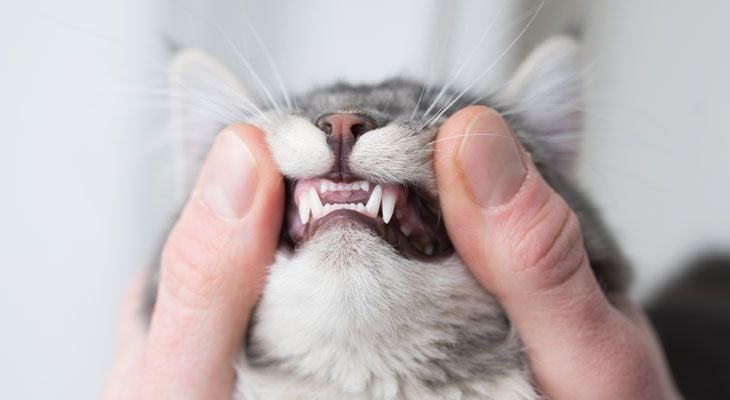
In addition to nutrition and weight management, oral care is another component that plays a part in a cat’s overall health. By lessening plaque buildup and stopping the plaque from forming dental tartar, you can prevent or control periodontal (gum) disease in your cat. Destruction of the teeth, tongue, gums and palate can lead to feline health risks, many of which can be prevented with regular oral care.
Understanding Your Cat’s Mouth
A cat’s breath will not smell pleasant, but it should not be odious. If his mouth is emitting a strong, offensive odor, this can be the sign of digestive problems or gingivitis (early-stage gum disease). Along with this smell test, your feline’s gums should be pink and firm. Gums that are white can mean poor circulation while red or inflamed gums could be a sign of gingivitis—which in itself can cause receding gums and tooth loss or the inability to eat—or underlying conditions like kidney disease and feline immunodeficiency virus (FIV).
Other things to watch out for are:
- Ulcers (either on the gums or tongue)
- Loose or broken teeth
- Pus
- Problems with properly chewing food
- Dark red lines along the gums
- Drooling
- Incessantly pawing at the mouth
These symptoms should be taken seriously, and, if they appear, a visit to your feline veterinarian is necessary.
Disorders of the Mouth
Now that you know what to look for, here are some diseases or conditions that can affect your cat’s mouth.
- Gingivitis. We have already discussed gingivitis, but let’s expand upon the subject a bit. This type of gum inflammation is often seen in older cats, but can affect cats of all ages. Typically, this condition begins with a visible, dark-red line on the border of the teeth. Over time, however, the gums may become painful and tender or ulcers may develop. This can occur alone or be the sign of an infection like FIV.
- Periodontitis (advanced-stage gum disease). When gingivitis is left untreated and attacks the tooth socket, a feline may suffer from loose teeth or tooth loss. Abscesses (fluid-filled sacs) may also form and cause infection.
- Stomatitis. This refers to inflammation of the lining of the mouth and may be brought on by dental problems, a viral disease or a strange object in the mouth. Cats with stomatitis find it difficult to eat. Also, the mouth may look red.
- Salivary cyst. Sometimes the salivary glands or ducts can become blocked with saliva. As we know, saliva contains bacteria. If the bacteria are stuck in the glands or ducts and festers, a cyst may form underneath the tongue.
- Mouth ulcers. Cats with kidney or respiratory disorders may display ulcers on their tongue or gums.
These and other disorders of the mouth can be diagnosed with a trip to the feline veterinarian. Your vet will inspect your cat’s mouth, teeth and gums for signs of disease. If disease is suspected, blood work, urinalysis and other tests may be performed. Treatment will then be administered, as you and your vet see fit.
Preventing Oral Disease With Home Care
Between your cat’s professional dental cleanings, there are things you can do at home to ensure your cat’s oral health is in order:
- Gently brush your cat’s teeth with either a toothbrush that is designed specifically for cats or with your finger. This should be done several times per week, if not daily. If you cat is reluctant to have you brush its teeth, you can ease him or her into the process by first letting him or her lick the dentifrice—one that is flavored to your cat’s liking (for example, poultry- or seafood-flavored)—from your finger and then off the toothbrush. Following this, slowly put the brush in your cat’s mouth and begin making gentle brushing motions. If your cat does not prefer a cat-specific toothbrush, finger brushes are available.
- Couple your cat-specific toothbrush with toothpaste that is designed specifically for felines. Human toothpaste can cause illness in cats.
- Use an anti-plaque antiseptic, such as chlorhexidine. This solution—which comes in the form of an oral rinse or gel—fastens to the oral tissues and tooth surfaces. It is also steadily released into your cat’s oral cavity. If you are using a rinse, squirt a tiny amount inside the cheeks; if you are using a gel, smudge it onto the teeth or apply it to the toothbrush or finger brush.
- Choose cat foods that fight the buildup of plaque and tartar. This may come in the form of dry kibble, which is designed to clear plaque as it comes into contact with the teeth—think of how an apple scrapes plaque off of yours. Some other cat foods may have a chemical, anti-tartar polyphosphate ingredient.
- Pick chew toys that floss your cat’s teeth, massage its gums and rub away soft tartar.
All these approaches can go a long way in your cat’s oral health. Expect some resistance at first, but, if you are patient, consistent and use a gentle approach, your cat should get used to the process over time. If you are hesitant about any of these at-home methods or if you have been unsuccessful in getting your cat to take to them, speak with your feline veterinarian.

